Efficient and Safe Strategies for Intersection Management: A Review
Abstract
1. Introduction
- To reduce the number of acidents on the road;
- To regulate the flow of vehicles and avoid congestion;
- To eusure the transmission of information for safe driving and improve the efficiency of the vehicle pass rate.
2. Safety
2.1. Intersection Collision Detection
2.1.1. Sensor-Based Detection Technology
| Detection Methods | Tool | Advantages | Disadvantages |
|---|---|---|---|
| Sensor-based detection [8,9] | radar, laser, lidar, etc. | Safe; measuring distance directly with less computing resources | Expensive, short range, less accurate |
| Vision-based detection [11,12] | camera | Cheap; wider range | More computations; affected by shadows from nearby buildings, overhead bridges or trees |
2.1.2. Vision-Detection Technology
2.2. Abnormal Information Warning(AIW)
2.2.1. Abnormal Vehicle Warning (AVW)
2.2.2. Control Loss Warning (CLW)
2.2.3. Hazardous Location Warning (HLW)
2.3. Summary
3. Efficiency
3.1. Jam Detection and Congestion Avoidance
3.1.1. Jam Detection
3.1.2. Congestion Avoidance
3.1.3. Summary
3.2. Green Light Optimized Speed Advisory (GLOSA)
3.2.1. Evaluation
3.2.2. Three Algorithms of GLOSA
3.2.3. Summary of GLOSA
3.3. Trajectory Planning
3.3.1. Algorithms
3.3.2. Summary of Trajectory Planning
3.4. Emergency Vehicle Priority
4. Conclusions
Author Contributions
Funding
Institutional Review Board Statement
Informed Consent Statement
Data Availability Statement
Acknowledgments
Conflicts of Interest
Abbreviations
| anti-lock braking system | ABS |
| Adaptive Cruise Control | ACC |
| Abnormal Vehicle Warning | AVW |
| body stability system | BSS |
| Control Loss Warning | CLW |
| convolutional neural network | CNN |
| connected vehicles | CVs |
| Dynamic Preemption Algorithm | DPA |
| elastic-band | EB |
| Emergency Vehicle Preemption | EVP |
| green light optimized speed advisory | GLOSA |
| Global Positioning System | GPS |
| Hazardous Location Warning | HLW |
| Hopfield Neural Network | HNN |
| host vehicle | hv |
| hybrid wavelet decomposition | HWD |
| Intelligent Driver Assistance System | IDAS |
| intelligent prediction model | IPM |
| intelligent traffic system | ITS |
| instrumented vehicles | IV |
| in-vehicle monitoring system | IVMS |
| lane offset warning system | LOW |
| map and transfer | MT |
| radio frequency identification | RFID |
| Reinforcement learning | RL |
| rapidly-exploring random tree | RRT |
| roadside units | RSU |
| remote vehicle | RV |
| signal phase and time | SPaT |
| support vector machines | SVMs |
| Timed coloured Petri nets | TCPN |
| traction control system | TCS |
| time elastic band | TEB |
| Traffic Signal Control System | TSCS |
| Vehicle-To-Infrastructure | V2I |
| Vehicle-To-Network | V2N |
| Vehicle-To-Pedestrian | V2P |
| Vehicle-To-Vehicle | V2V |
| Vehicular Adhoc Networks | VANETs |
| signal phase and time | SPaT |
| wavelet zero padding | WZP |
| artificial intelligence | AI |
References
- Choi, E.H. Crash factors in intersection-related crashes: An on-scene perspective. 2010. Available online: https://trid.trb.org/view/1083638 (accessed on 10 January 2021).
- Lasley, P. 2019 Urban mobility report. 2019. Available online: https://static.tti.tamu.edu/tti.tamu.edu/documents/mobility-report-2019-appx-b.pdf (accessed on 10 January 2021).
- Kiela, K.; Barzdenas, V.; Jurgo, M.; Macaitis, V.; Rafanavicius, J.; Vasjanov, A.; Kladovscikov, L.; Navickas, R. Review of V2X–IoT standards and frameworks for ITS applications. Appl. Sci. 2020, 10, 4314. [Google Scholar] [CrossRef]
- Engoulou, R.G.; Bellaïche, M.; Pierre, S.; Quintero, A. VANET security surveys. Comput. Commun. 2014, 44, 1–13. [Google Scholar] [CrossRef]
- Chen, S.; Hu, J.; Shi, Y.; Peng, Y.; Fang, J.; Zhao, R.; Zhao, L. Vehicle-to-everything (V2X) services supported by LTE-based systems and 5G. IEEE Commun. Stand. Mag. 2017, 1, 70–76. [Google Scholar] [CrossRef]
- World Health Organization. Global Status Report on Road Safety 2018: Summary; World Health Organization: Geneva, Switzerland, 2018. [Google Scholar]
- Chen, Y.; Zhao, D.; Lv, L.; Zhang, Q. Multi-task learning for dangerous object detection in autonomous driving. Inf. Sci. 2018, 432, 559–571. [Google Scholar] [CrossRef]
- Canzian, L.; Demiryurek, U.; van der Schaar, M. Collision detection by networked sensors. IEEE Trans. Signal Inf. Process. Over Netw. 2015, 2, 1–15. [Google Scholar] [CrossRef]
- Liyanage, Y.W.; Zois, D.S.; Chelmis, C. Robust Freeway Accident Detection: A Two—Stage Approach. In Proceedings of the ICASSP 2019-2019 IEEE International Conference on Acoustics, Speech and Signal Processing (ICASSP), Brighton, UK, 12–17 May 2019; pp. 3387–3391. [Google Scholar]
- Liyanage, Y.W.; Zois, D.S.; Chelmis, C. Optimal Sequential Detection of Freeway Accidents. In Proceedings of the 2018 52nd Asilomar Conference on Signals, Systems, and Computers, Pacific Grove, CA, USA, 28–31 October 2018; pp. 2055–2059. [Google Scholar]
- Lv, L.; Zhao, D.; Deng, Q. A semi-supervised predictive sparse decomposition based on task-driven dictionary learning. Cogn. Comput. 2017, 9, 115–124. [Google Scholar] [CrossRef]
- Redmon, J.; Divvala, S.; Girshick, R.; Farhadi, A. You only look once: Unified, real-time object detection. In Proceedings of the IEEE conference on computer vision and pattern recognition, Las Vegas, NV, USA, 27–30 June 2016; pp. 779–788. [Google Scholar]
- Yu, Y.; Xu, M.; Gu, J. Vision-based traffic accident detection using sparse spatio-temporal features and weighted extreme learning machine. IET Intell. Transp. Syst. 2019, 13, 1417–1428. [Google Scholar] [CrossRef]
- Song, L.; Dai, J.; Duan, H.; Liu, Z.; Liu, N. Abnormal Event Detection Based on in Vehicle Monitoring System. In International Conference on Applications and Techniques in Cyber Security and Intelligence; Edizioni della Normale: Cham, Switzerland, 2017; pp. 275–280. [Google Scholar]
- Khac, C.N.; Park, J.H.; Jung, H.Y. Detection of abnormal moving vehicles for intelligent driver assistance system. In Proceedings of the 2016 International Conference on Electronics, Information, and Communications (ICEIC), Danang, Vietnam, 27–30 January 2016; pp. 1–4. [Google Scholar]
- Menelaou, C.; Timotheou, S.; Kolios, P.; Panayiotou, C.G.; Polycarpou, M.M. Minimizing traffic congestion through continuous-time route reservations with travel time predictions. IEEE Trans. Intell. Veh. 2018, 4, 141–153. [Google Scholar] [CrossRef]
- Li, X. A new fast hybrid algorithm of background extraction suitable for the DSP platform. WRI World Congr. Comput. Sci. Inf. Eng. 2009, 7, 1–4. [Google Scholar]
- Lei, X.; Qing, W.; Xiumin, C.; Jun, W.; Ping, C. Traffic jam detection based on corner feature of background scene in video-based ITS. In Proceedings of the 2008 IEEE International Conference on Networking, Sensing and Control, Sanya, China, 6–8 April 2008; pp. 614–619. [Google Scholar]
- Diop, A.K.; Tall, K.; Farssi, S.M.; Samb, N.A.; Tambedou, M. Cross-Correlation to Assess the State of Traffic Jam in CCTV Systems. In Proceedings of the 2020 International Conference on Electrical, Communication, and Computer Engineering (ICECCE), Istanbul, Turkey, 12–13 June 2020; pp. 1–4. [Google Scholar]
- Davarpanah, S.H.; Khalid, F.; Abdullah, L.N. BGLBP-based image background extraction method. Int. Arab J. Inf. Technol. 2016, 13, 908–914. [Google Scholar]
- Rafi, M.; Mukhopadhyay, S. Texture segmentation from non-textural background using enhanced MTC. Int. Arab J. Inf. Technol. 2019, 16, 737–745. [Google Scholar]
- Kim, K.; Chalidabhongse, T.H.; Harwood, D.; Davis, L. Real-time foreground—Background segmentation using codebook model. Real-Time Imaging 2005, 11, 172–185. [Google Scholar] [CrossRef]
- Reddy, P.J.; Reddy, M.V.N.; Krishna, P.P.M. Enhancement of Ariel Images: A Review. Int. J. Res. 2015, 3, 1961–1966. [Google Scholar]
- Marszalek, Z.; Duda, K. Vehicle Magnetic Signature Compatibility for Inductive Loop Sensor with Various Signal Conditioning Systems. In Proceedings of the 2018 International Conference on Signals and Electronic Systems (ICSES), Krakow, Poland, 10–12 September 2018; pp. 33–36. [Google Scholar]
- Khoenkaw, P.; Pramokchon, P. An Implementation of Automatic Inductive-Loop Vehicle Sensor Using Low-Cost Microcontroller. In Proceedings of the 2019 Joint International Conference on Digital Arts, Media and Technology with ECTI Northern Section Conference on Electrical, Electronics, Computer and Telecommunications Engineering (ECTI DAMT-NCON), Nan, Thailand, 30 January–2 February 2019; pp. 331–334. [Google Scholar]
- Bao, X.; Li, H.; Xu, D.; Jia, L.; Ran, B.; Rong, J. Traffic vehicle counting in jam flow conditions using low-cost and energy-efficient wireless magnetic sensors. Sensors 2016, 16, 1868. [Google Scholar] [CrossRef] [PubMed]
- Fimbombaya, H.S.; Mvungi, N.H.; Hamisi, N.Y.; Iddi, H.U. Enhanced Magnetic Wireless Sensor Network Algorithm for Traffic Flow Monitoring in Low-Speed Congested Traffic. J. Electr. Comput. Eng. 2020, 2020. [Google Scholar] [CrossRef]
- Na, Y.; Guo, Y.; Fu, Q.; Yan, Y. An acoustic traffic monitoring system: Design and implementation. In Proceedings of the 2015 IEEE 12th Intl Conf on Ubiquitous Intelligence and Computing and 2015 IEEE 12th Intl Conf on Autonomic and Trusted Computing and 2015 IEEE 15th Intl Conf on Scalable Computing and Communications and Its Associated Workshops (UIC-ATC-ScalCom), Beijing, China, 10–14 August 2015; pp. 119–126. [Google Scholar]
- Ma, Q.; Kockelman, K. A Low-Cost GPS-Data-Enhanced Approach for Traffic Network Evaluations. Int. J. Intell. Transp. Syst. Res. 2019, 17, 9–17. [Google Scholar] [CrossRef]
- Kataoka, K.; Gangwar, S.; Mudda, K.Y.; Mandal, S. A smartphone-based probe data platform for road management and safety in developing countries. In Proceedings of the 2018 IEEE International Conference on Data Mining Workshops (ICDMW), Singapore, 17–20 November 2018; pp. 612–615. [Google Scholar]
- Hu, W.; Wang, H.; Yan, L. An actual urban traffic simulation model for predicting and avoiding traffic congestion. In Proceedings of the 17th International IEEE Conference on Intelligent Transportation Systems (ITSC), Qingdao, China, 8–11 October 2014; pp. 2681–2686. [Google Scholar]
- Zheng, Y.; Li, Y.; Own, C.M.; Meng, Z.; Gao, M. Real-time predication and navigation on traffic congestion model with equilibrium Markov chain. Int. J. Distrib. Sens. Netw. 2018, 14, 1550147718769784. [Google Scholar] [CrossRef]
- Zhang, S.; Li, S.; Li, X.; Yao, Y. Representation of traffic congestion data for urban road traffic networks based on pooling operations. Algorithms 2020, 13, 84. [Google Scholar] [CrossRef]
- Abdelwahab, M.A.; Abdel-Nasser, M.; Hori, M. Reliable and Rapid Traffic Congestion Detection Approach Based on Deep Residual Learning and Motion Trajectories. IEEE Access 2020, 8, 182180–182192. [Google Scholar] [CrossRef]
- Liu, H.; Liang, W.; Rai, L.; Teng, K.; Wang, S. A real-time queue length estimation method based on probe vehicles in CV environment. IEEE Access 2019, 7, 20825–20839. [Google Scholar] [CrossRef]
- Comert, G.; Cetin, M. Queue Length Estimation at Traffic Signals: Connected Vehicles with Range Measurement Sensors. arXiv 2020, arXiv:2011.09397. [Google Scholar]
- Gupta, V.; Kumar, R.; Reddy, K.S.; Panigrahi, B.K. Intelligent traffic light control for congestion management for smart city development. In Proceedings of the 2017 IEEE Region 10 Symposium (TENSYMP), Cochin, India, 14–16 July 2017; pp. 1–5. [Google Scholar]
- Stahlmann, R.; Möller, M.; Brauer, A.; German, R.; Eckhoff, D. Exploring GLOSA systems in the field: Technical evaluation and results. Comput. Commun. 2018, 120, 112–124. [Google Scholar] [CrossRef]
- Suzuki, H.; Marumo, Y. A new approach to green light optimal speed advisory (GLOSA) systems and its limitations in traffic flows. In International Conference on Human Systems Engineering and Design: Future Trends and Applications; Springer: Cham, Switzerland, 2018; pp. 776–782. [Google Scholar]
- Katsaros, K.; Kernchen, R.; Dianati, M.; Rieck, D. Performance study of a Green Light Optimized Speed Advisory (GLOSA) application using an integrated cooperative ITS simulation platform. In Proceedings of the 2011 7th International Wireless Communications and Mobile Computing Conference, Istanbul, Turkey, 4–8 July 2011; pp. 918–923. [Google Scholar]
- Xin, Q.; Fu, R.; Yuan, W.; Liu, Q.; Yu, S. Predictive intelligent driver model for eco-driving using upcoming traffic signal information. Phys. Stat. Mech. Appl. 2018, 508, 806–823. [Google Scholar] [CrossRef]
- Yu, S.; Fu, R.; Guo, Y.; Xin, Q.; Shi, Z. Consensus and optimal speed advisory model for mixed traffic at an isolated signalized intersection. Phys. Stat. Mech. Its Appl. 2019, 531, 121789. [Google Scholar] [CrossRef]
- Guan, T.; Frey, C.W. Predictive energy efficiency optimization of an electric vehicle using information about traffic light sequences and other vehicles. In Proceedings of the 2016 IEEE 19th International Conference on Intelligent Transportation Systems (ITSC), Rio de Janeiro, Brazil, 1–4 November 2016; pp. 919–926. [Google Scholar]
- Kundu, S.; Kundu, S. Flexible vehicle speed control algorithms for eco-driving. In Proceedings of the 2015 IEEE 82nd Vehicular Technology Conference (VTC2015-Fall), Boston, MA, USA, 6–9 September 2015; pp. 1–5. [Google Scholar]
- Guan, T.; Frey, C.W. Improvement of predictive energy efficiency optimization using long distance horizon estimation. In Proceedings of the 2017 IEEE Intelligent Vehicles Symposium (IV), Los Angeles, CA, USA, 11–14 June 2017; pp. 1249–1255. [Google Scholar]
- Jeoung, D.; Min, K.; Sunwoo, M. Automatic Transmission Shift Strategy Based on Greedy Algorithm Using Predicted Velocity. Int. J. Automot. Technol. 2020, 21, 159–168. [Google Scholar] [CrossRef]
- Yi, B.; Bender, P.; Bonarens, F.; Stiller, C. Model predictive trajectory planning for automated driving. IEEE Trans. Intell. Veh. 2018, 4, 24–38. [Google Scholar] [CrossRef]
- Wuthishuwong, C.; Traechtler, A.; Bruns, T. Safe trajectory planning for autonomous intersection management by using vehicle to infrastructure communication. EURASIP J. Wirel. Commun. Netw. 2015, 2015, 1–12. [Google Scholar] [CrossRef]
- Paden, B.; Čáp, M.; Yong, S.Z.; Yershov, D.; Frazzoli, E. A survey of motion planning and control techniques for self-driving urban vehicles. IEEE Trans. Intell. Veh. 2016, 1, 33–55. [Google Scholar] [CrossRef]
- Sattel, T.; Brandt, T. Ground vehicle guidance along collision-free trajectories using elastic bands. In Proceedings of the 2005, American Control Conference, Portland, OR, USA, 8–10 June 2005; pp. 4991–4996. [Google Scholar]
- Tho, Q.H.; Phap, H.C.; Phuong, P.A. A Predictive Control Solution for Contingency Motion Planning for Autonomous Vehicle. In Proceedings of the 2019 IEEE-RIVF International Conference on Computing and Communication Technologies (RIVF), Danang, Vietnam, 20–22 March 2019; pp. 1–6. [Google Scholar]
- Keller, M.; Hoffmann, F.; Hass, C.; Bertram, T.; Seewald, A. Planning of optimal collision avoidance trajectories with timed elastic bands. IFAC Proc. Vol. 2014, 47, 9822–9827. [Google Scholar] [CrossRef]
- Ning, Y.; Yue, M.; Yang, L.; Hou, X. A trajectory planning and tracking control approach for obstacle avoidance of wheeled inverted pendulum vehicles. Int. J. Control. 2020, 93, 1735–1744. [Google Scholar] [CrossRef]
- Fassbender, D.; Heinrich, B.C.; Wuensche, H.J. Motion planning for autonomous vehicles in highly constrained urban environments. In Proceedings of the 2016 IEEE/RSJ International Conference on Intelligent Robots and Systems (IROS), Daejeon, Korea, 9–14 October 2016; pp. 4708–4713. [Google Scholar]
- Hart, P.E.; Nilsson, N.J.; Raphael, B. A formal basis for the heuristic determination of minimum cost paths. IEEE Trans. Syst. Sci. Cybern. 1968, 4, 100–107. [Google Scholar] [CrossRef]
- Moffat, A. Empirical survey of shortest path algorithms. NZ Oper. Res. 1983, 11, 153–164. [Google Scholar]
- Tuncali, C.E.; Fainekos, G. Rapidly-exploring random trees for testing automated vehicles. In Proceedings of the 2019 IEEE Intelligent Transportation Systems Conference, Auckland, New Zealand, 27–30 October 2019; pp. 661–666. [Google Scholar]
- Li, B.; Kong, Q.; Zhang, Y.; Shao, Z.; Wang, Y.; Peng, X.; Yan, D. On-road Trajectory Planning with Spatio-temporal RRT* and Always-feasible Quadratic Program. In Proceedings of the 2020 IEEE 16th International Conference on Automation Science and Engineering (CASE), Hong Kong, China, 20–21 August 2020; pp. 942–947. [Google Scholar]
- Tong, L. A Speedup Convergent Method for Multi-Agent Reinforcement Learning. In Proceedings of the 2009 International Conference on Information Engineering and Computer Science, Wuhan, China, 19–20 December 2009; pp. 1–4. [Google Scholar]
- González, D.; Pérez, J.; Milanés, V.; Nashashibi, F. A review of motion planning techniques for automated vehicles. IEEE Trans. Intell. Transp. Syst. 2015, 17, 1135–1145. [Google Scholar] [CrossRef]
- Watkins, C.J.C.H.; Dayan, P. Q-learning. Mach. Learn. 1992, 8, 279–292. [Google Scholar] [CrossRef]
- Siddique, N.; Adeli, H. Water drop algorithms. Int. J. Artif. Intell. Tools 2014, 23, 1430002. [Google Scholar] [CrossRef]
- Zhang, W.; Gong, X.; Han, G.; Zhao, Y. An improved ant colony algorithm for path planning in one scenic area with many spots. IEEE Access 2017, 5, 13260–13269. [Google Scholar] [CrossRef]
- Mouhagir, H.; Talj, R.; Cherfaoui, V.; Guillemard, F.; Aioun, F. A markov decision process-based approach for trajectory planning with clothoid tentacles. In Proceedings of the 2016 IEEE Intelligent Vehicles Symposium (IV), Gothenburg, Sweden, 19–22 June 2016; pp. 1254–1259. [Google Scholar]
- Weinert, F.; Düring, M. Development and Assessment of Cooperative v2x Applications for Emergency Vehicles in an Urban Environment Enabled by Behavioral Models; Modeling Mobility with Open Data; Springer: Cham, Switzerland, 2015; pp. 125–153. [Google Scholar]
- McHale, G.M. An Assessment Methodology for Emergency Vehicle Traffic Signal Priority Systems. Ph.D. Thesis, Virginia Tech, Blacksburg, Virginia, 2002. [Google Scholar]
- Chao, M.A.; Jian-Xun, C.U.I. Multiple emergency vehicles signal priority control based on multi-agent approach. J. Transp. Syst. Eng. Inf. Technol. 2013, 85–92. [Google Scholar]
- Chentoufi, M.A.; Ellaia, R. Adaptive traffic signal optimization considering emergency vehicle preemption and tram priority using PVS algorithm. In Proceedings of the 3rd International Conference on Smart City Applications, Tetouan, Morocco, 2–4 October 2018; pp. 1–8. [Google Scholar]
- Mu, H.; Liu, L.; Li, X. Signal preemption control of emergency vehicles based on timed colored petri nets. Discret. Dyn. Nat. Soc. 2018, 1–12. [Google Scholar] [CrossRef]
- Louati, A.; Elkosantini, S.; Darmoul, S.; Louati, H. Multi-agent preemptive longest queue first system to manage the crossing of emergency vehicles at interrupted intersections. Eur. Transp. Res. Rev. 2018, 10, 1–21. [Google Scholar] [CrossRef]
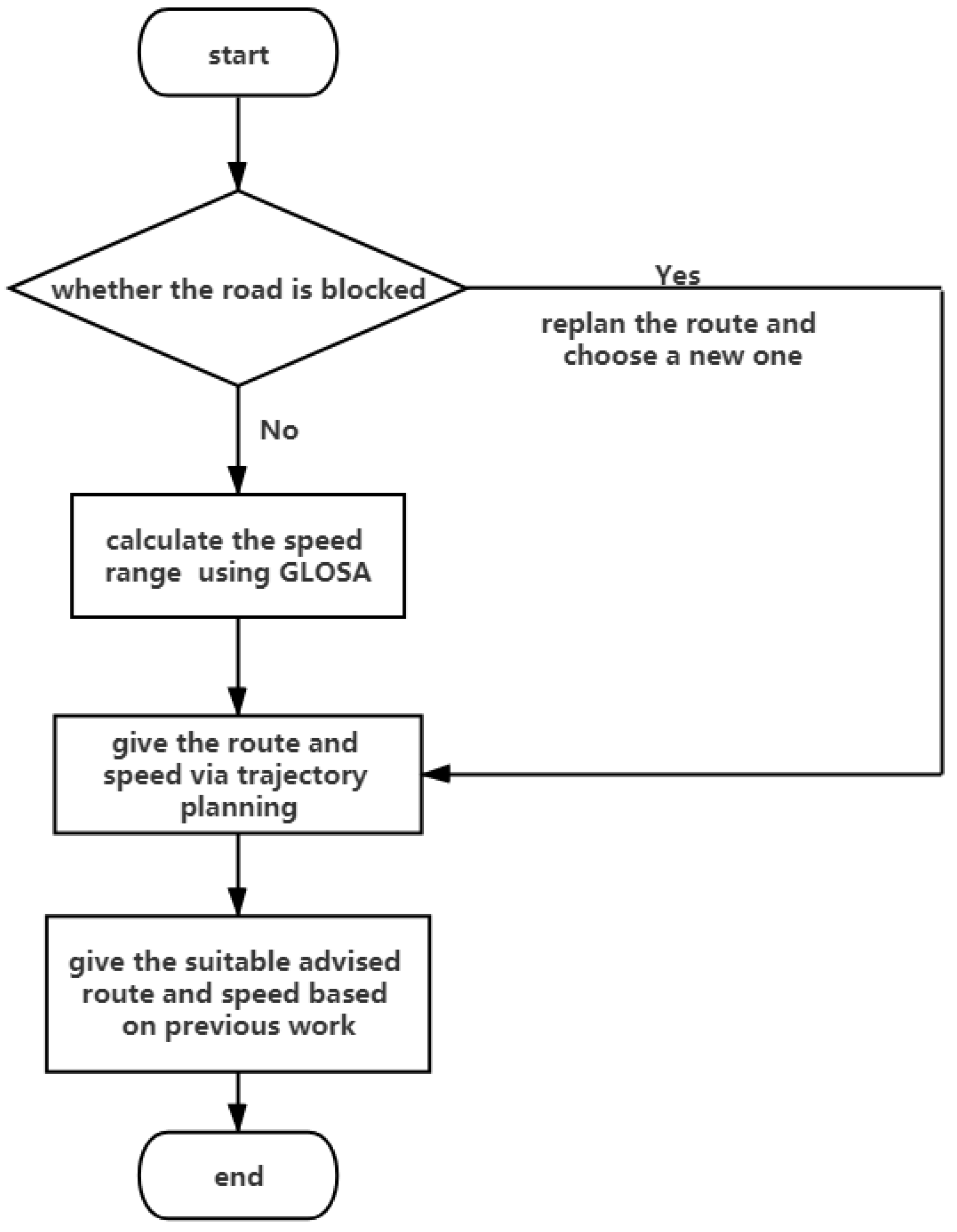
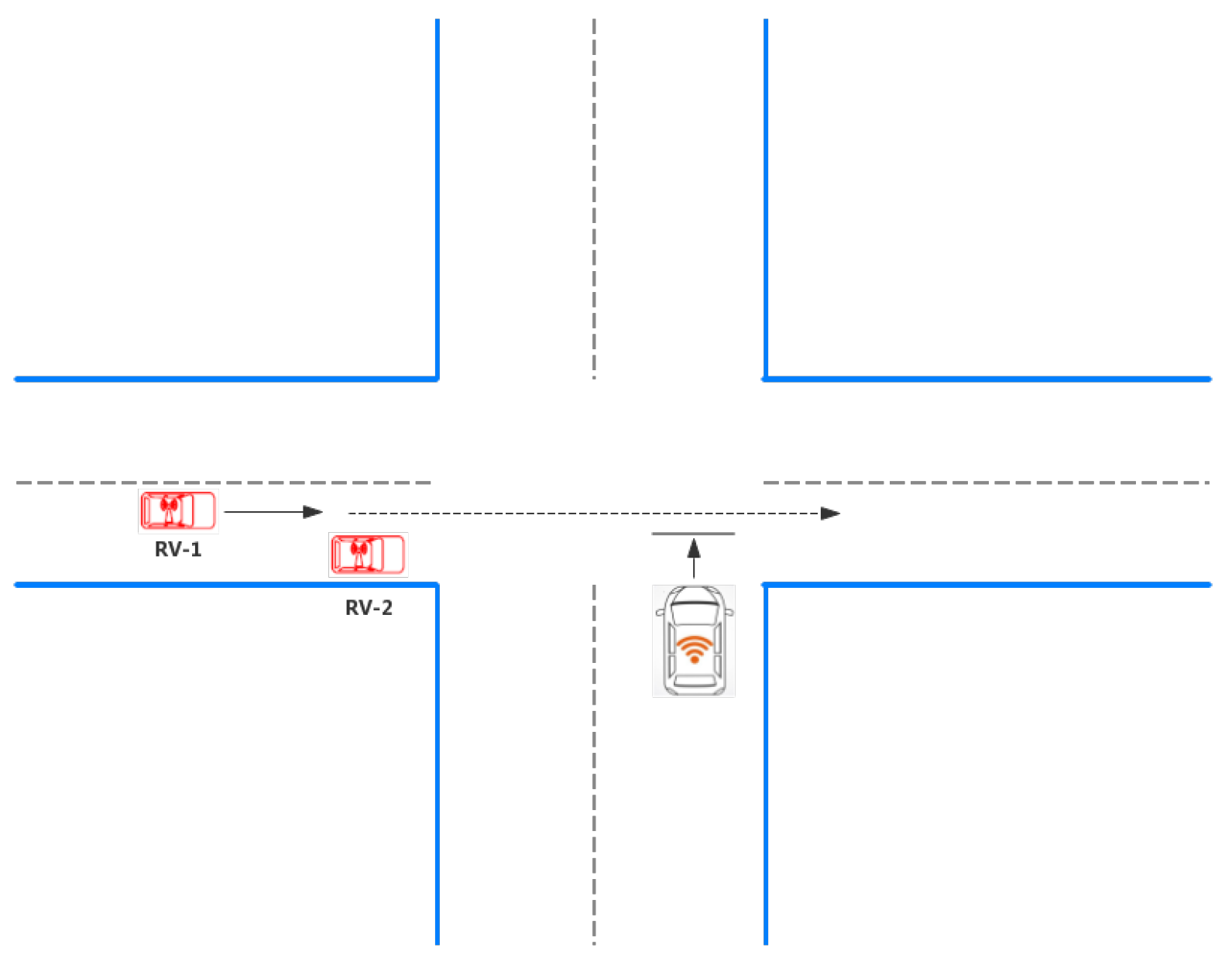
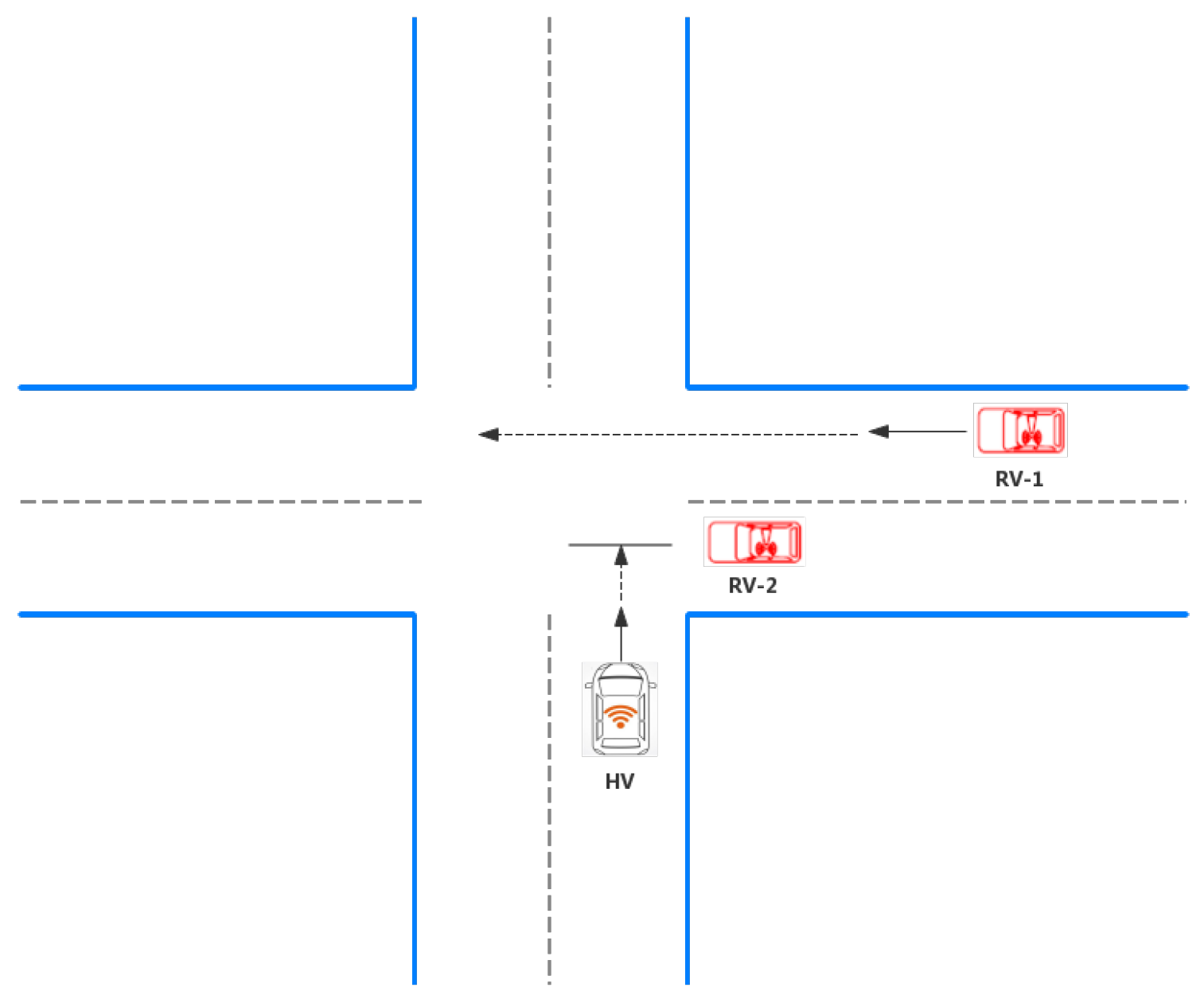
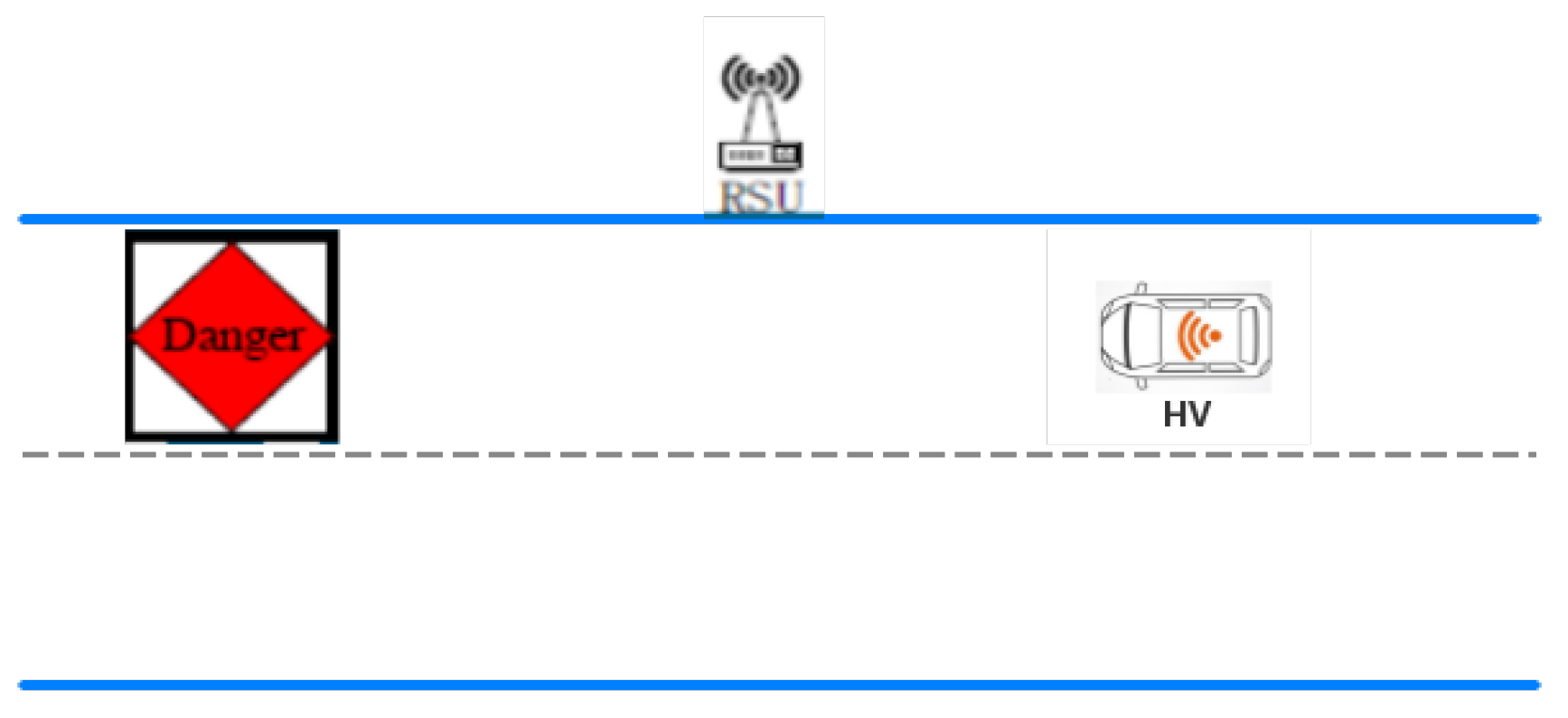
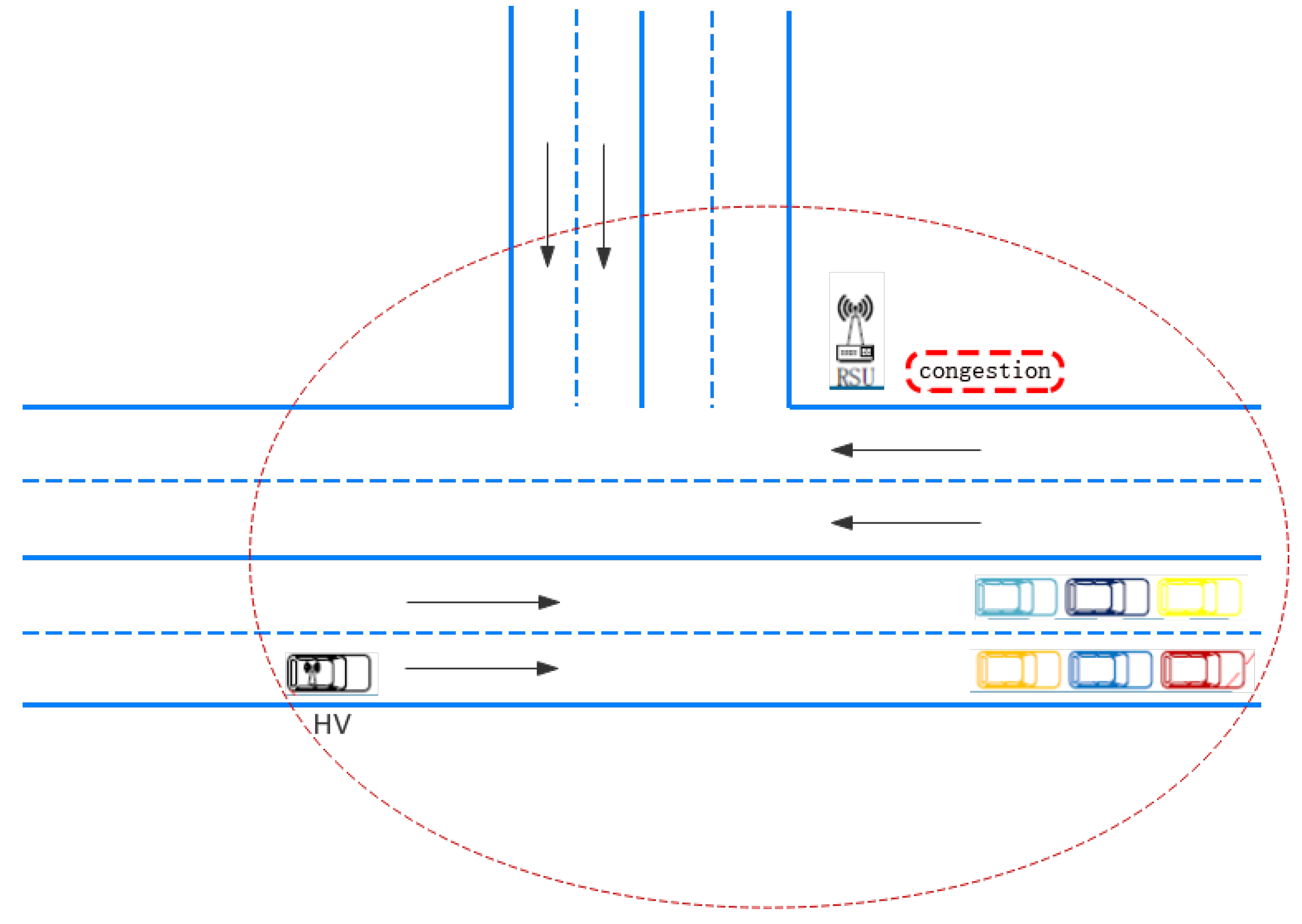
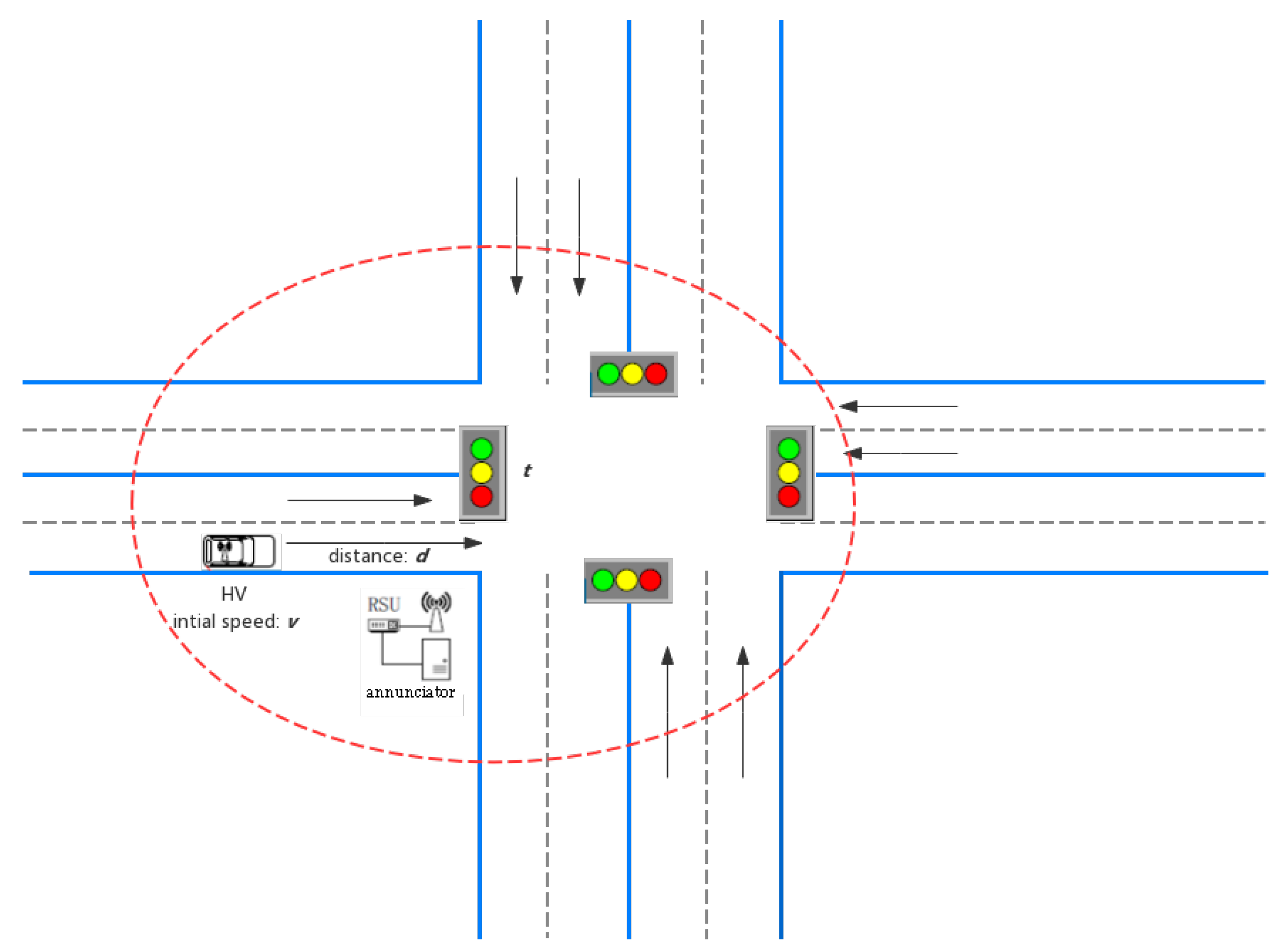
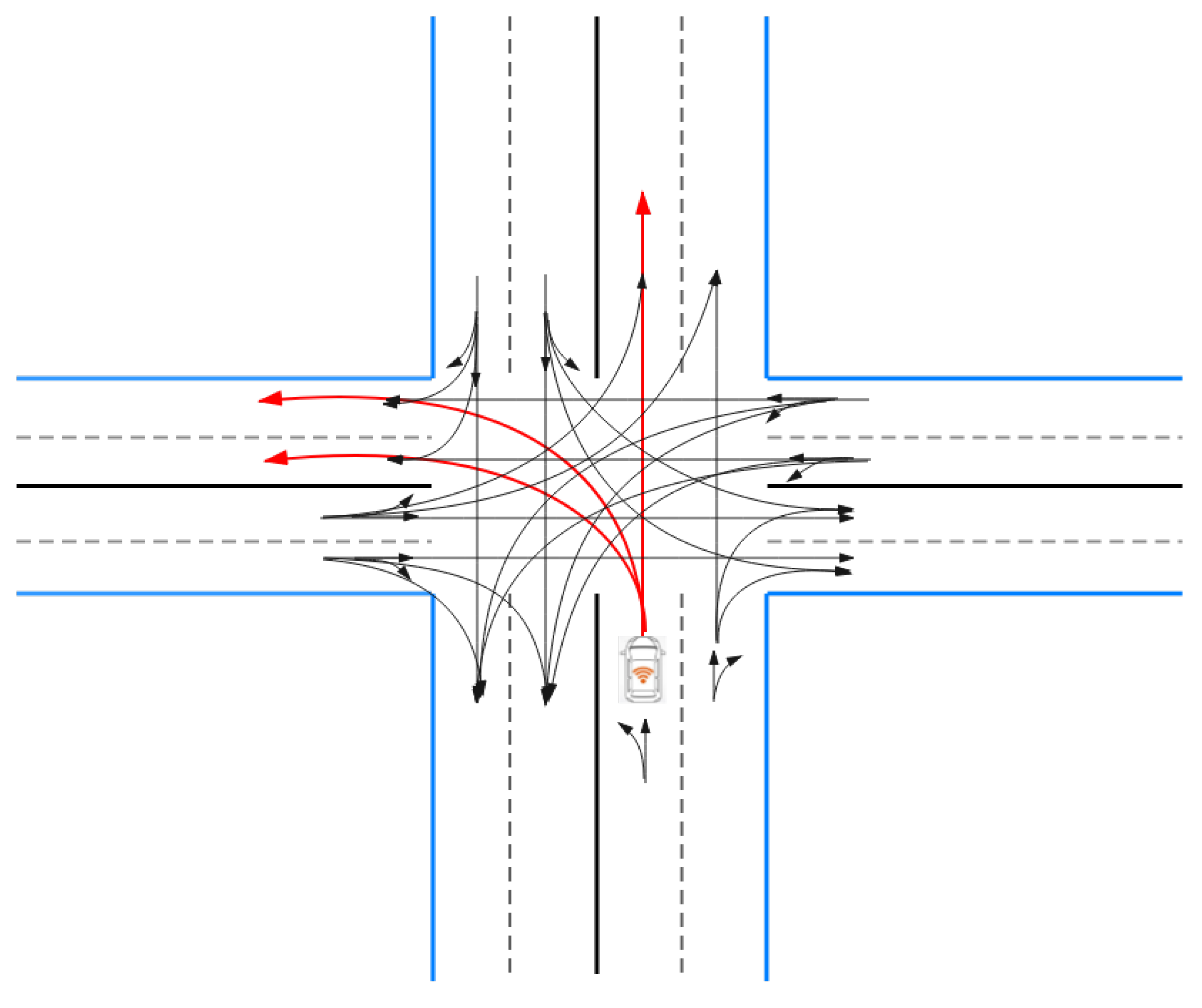

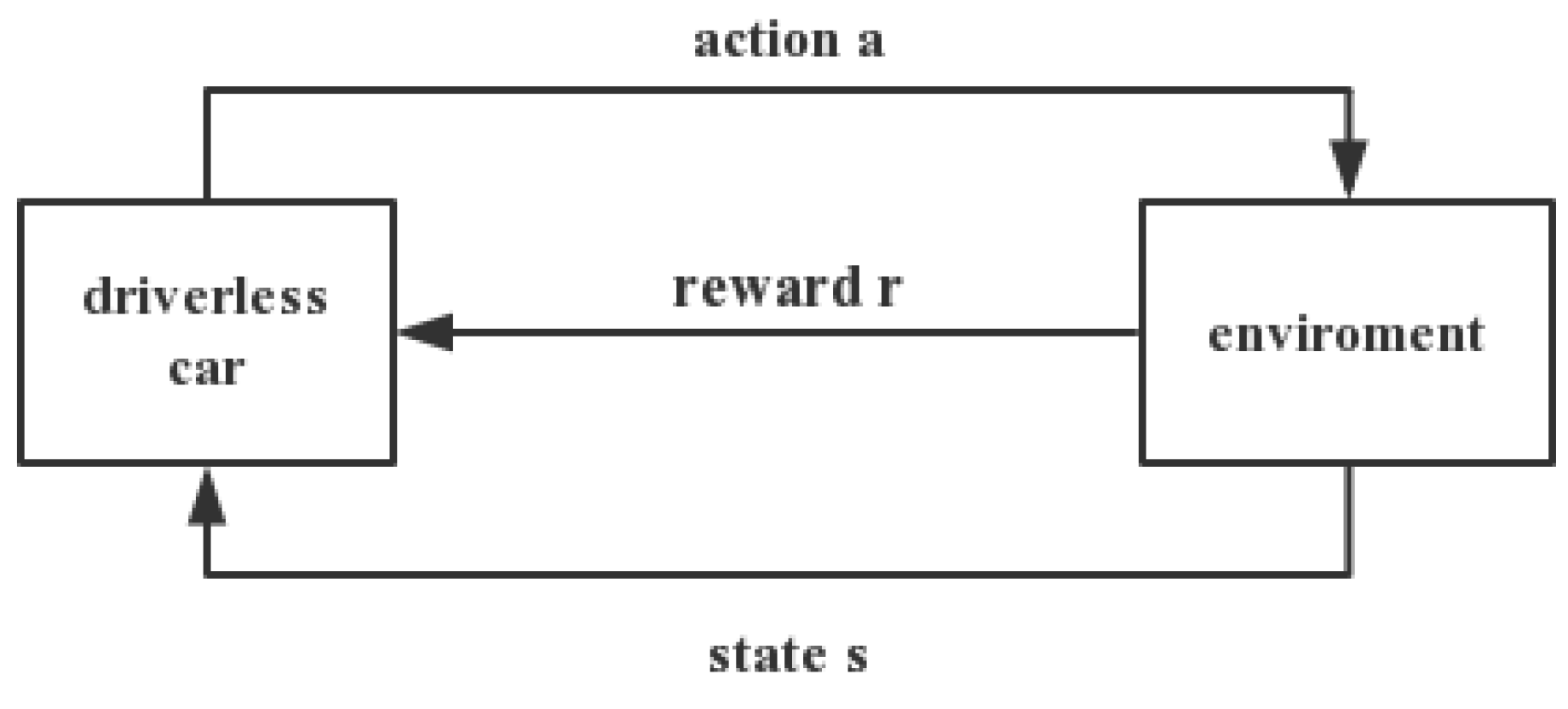
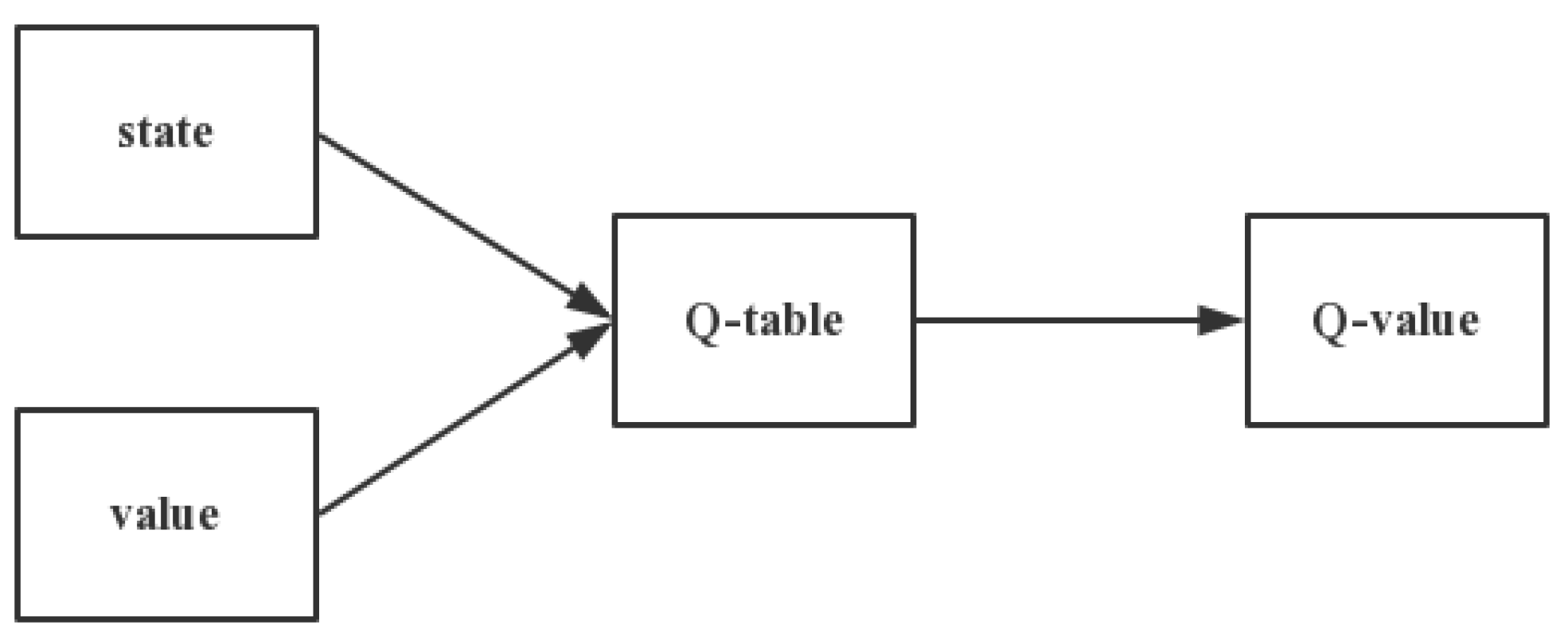
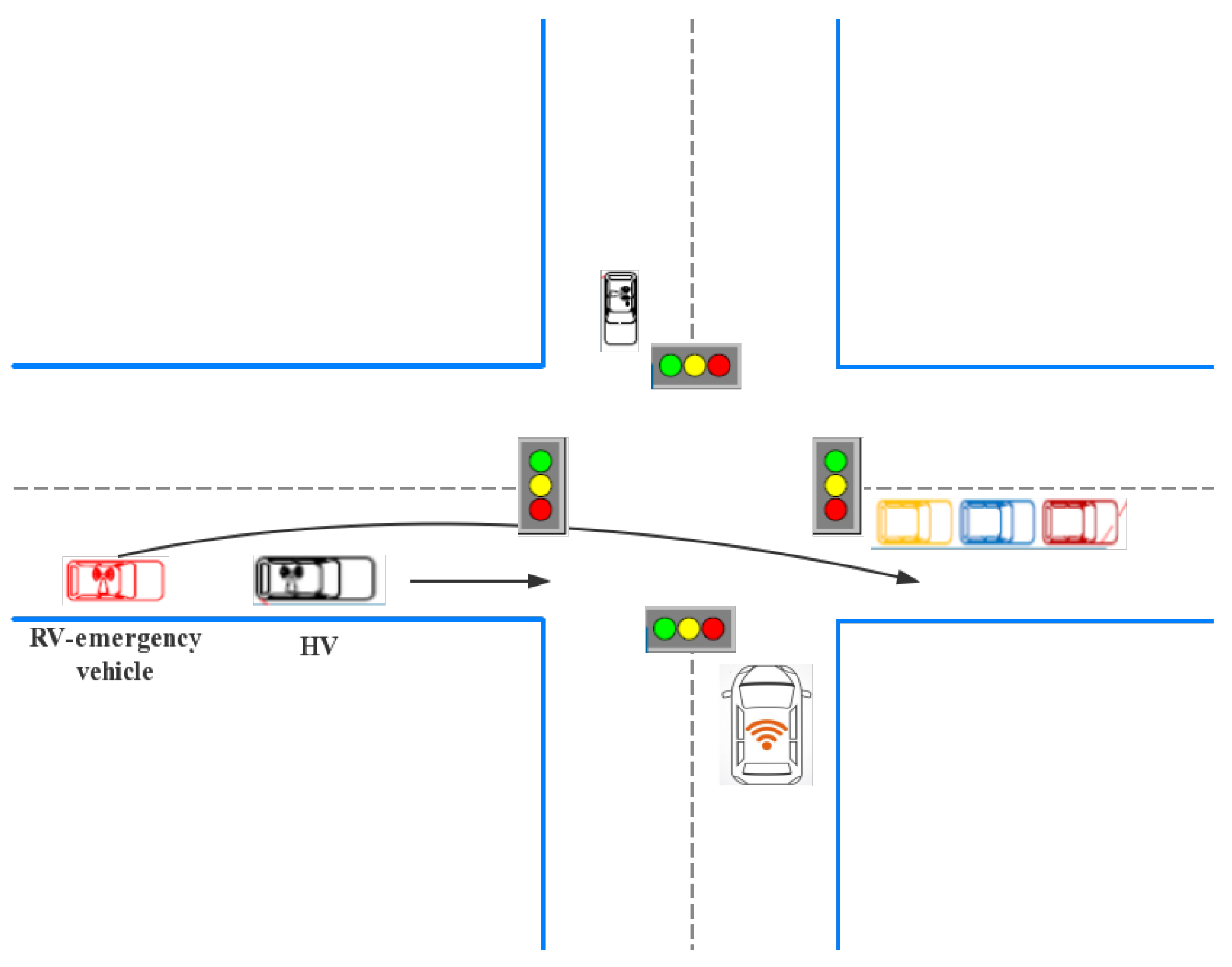
| Criteria | Data Range |
|---|---|
| HV speed | 0–130 km/h |
| Communication distance | >= 300 m |
| Position accuracy | <= 5 m |
| Type | Usage Scenario | Zone of Application | Examples |
|---|---|---|---|
| Abnormal vehicle warning | Radar, laser, lidar, etc. | Intersections; roads of cities and suburban | IVMS [7] |
| Control loss warning | ABS, ESP, TCS, and LDW of RV | Roads of cities and suburban | IDAS [14] |
| Hazardous location warning | Potentially dangerous condition (e.g., holes of road surface) | Road bends; the bad situation of road | Interchange server [15] |
| Type | Model | Main Technology | Advantages | Need To Be Improved |
|---|---|---|---|---|
| Using prediction algorithm | AUTM [31] | Map and transfer; optimized spatial evolution rules; a congestion avoidance routing algorithm | Congesting forecasting more than 89% | Considering more realistic features in AUTM; applying dynamic strategy of traffic light; short of real-time |
| An advanced dynamic traffic network prediction and navigation model [32] | Equilibrium Markov chain model; time-dependent navigation algorithm | Average speed improved | Network adaptation and robustness; making the network into real-time; self-update | |
| VANET | A real-time queue length estimation method [35] | Using Markov model to estimate the real-time CV; the real-time queue length estimation | Good performance in handling the randomness; high accuracy in real-time queue length estimation | The impact of queue estimation accuracy caused by different CV distributions in the queue |
| Algorithm | CO Emission Reduction | Fuel Consumption Reduction | Travel Time Reduction |
|---|---|---|---|
| An extension of IDM and eco-driving model [41] | 7.9% | 2.3% | 1.5% |
| A model predictive optimization approach [43] | 6.2% | 9% | 4.1% |
| GDA [46] | 6.8% | 7.1% | 6.8% |
| MCG [44] | 5.7% | 4.2% | 3.4% |
| MCG-EA [44] | 6.1% | 2.1% | 2.4% |
| LOSB-F [44] | 6.3% | 1.5% | 2.0% |
| LOSB-E [44] | 6.4% | 2.5% | 1.7% |
| Algorithm | Real-Time | Robustness | Time Complexity |
|---|---|---|---|
| State lattice [49] | 85% | ++ | ++++ |
| EB [50] | 75% | + | ++++ |
| A* [54] | 88% | ++ | +++ |
| RRT [57] | 79% | ++ | ++ |
| Q-learning [60] | 90% | +++++ | ++ |
| Algorithm | Method | Result |
|---|---|---|
| The multi-agent EV signal priority control system [67] | Fuzzy logic theory; phase agent and management agent | Passing time decreases by 16.4% and stop times reduce by 8.21% |
| DPA [68] | The acyclic signal operation based on a real time control approach; Passing Vehicle Search algorithm (PVS) | The delay decreases by 12.51% |
| TCPN [69] | Establish a traffic flow model; traffic signal display and phase switching model and traffic signal switching control model | The maximal improvement rate compared with the traditional method is 29.49% |
| A distributed Traffic Signal Control System (TSCS) [70] | LQF-MWM assumptions, preemption technique; multi-agent system | The system reduces the total travel time by 11.7% and 27.02% compared to MAS-P-OSBFX-240S and MAS-P-OSBFX-60S |
Publisher’s Note: MDPI stays neutral with regard to jurisdictional claims in published maps and institutional affiliations. |
© 2021 by the authors. Licensee MDPI, Basel, Switzerland. This article is an open access article distributed under the terms and conditions of the Creative Commons Attribution (CC BY) license (https://creativecommons.org/licenses/by/4.0/).
Share and Cite
Wang, J.; Guo, X.; Yang, X. Efficient and Safe Strategies for Intersection Management: A Review. Sensors 2021, 21, 3096. https://doi.org/10.3390/s21093096
Wang J, Guo X, Yang X. Efficient and Safe Strategies for Intersection Management: A Review. Sensors. 2021; 21(9):3096. https://doi.org/10.3390/s21093096
Chicago/Turabian StyleWang, Jian, Xinyu Guo, and Xinyu Yang. 2021. "Efficient and Safe Strategies for Intersection Management: A Review" Sensors 21, no. 9: 3096. https://doi.org/10.3390/s21093096
APA StyleWang, J., Guo, X., & Yang, X. (2021). Efficient and Safe Strategies for Intersection Management: A Review. Sensors, 21(9), 3096. https://doi.org/10.3390/s21093096






